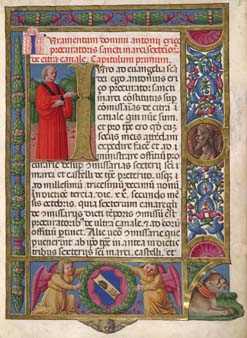The Humanistic ManuscriptAt the University Library
In Italy in the early fifteenth century a revolution took place in the script and decoration of the manuscript book, first in Florence, and very soon after in the rest of the peninsula. It involved the rediscovery of classical texts, the revival of ancient literature as a central element of the curriculum, the reform of Latin spelling, and a new style of writing, called by its contemporaries littera antica and known to us today as ‘humanistic script’. The new type of book received a new style of decoration. At first,
it was limited to the white-vine scrolls meandering around birds,
butterflies, and chubby little boys, the ubiquitous putti. But by
the mid-fifteenth century, illuminators were experimenting with
three-dimensional images corresponding to the antiquarian passions
of Humanist scholars and collectors. Ancient inscriptions, jewels,
and archaeological finds inspired the illusionistic monumental frontispieces
and architectural title pages, one of the most lasting contributions
of the Humanistic manuscript to book design.
|
||
